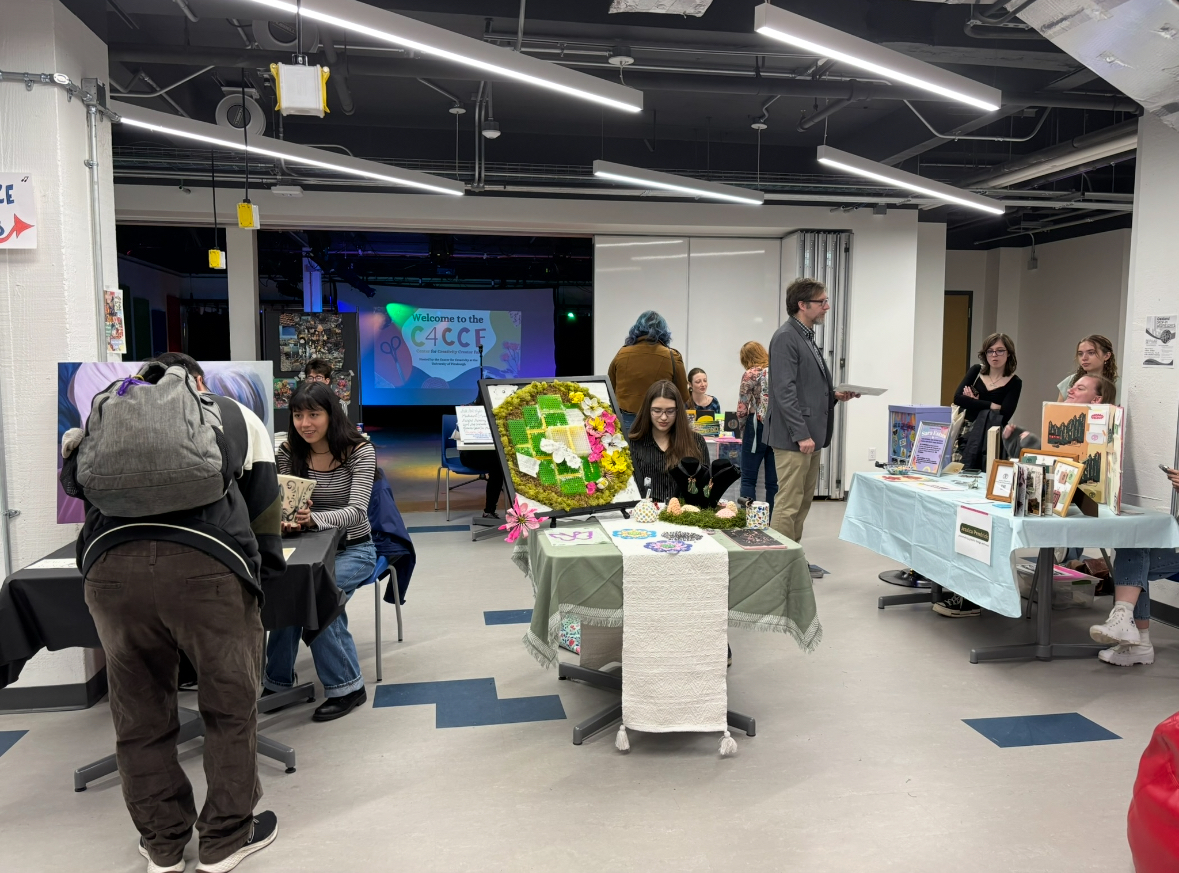Tucked away in the basement of Cathy, Pitt’s Center for Creativity: The Understory serves as a lighthouse for students looking to pursue creative endeavors. The Center for Creativity’s Inaugural Creator Fair on April 5 gave student artists the opportunity to showcase their work to the public.
The Creator Fair took place in a small yet welcoming space. C4C faculty smiled and kindly greeted each attendee upon their entrance. In addition to the welcoming faculty, the space itself displayed cheerful, colorful decorations. Colorful seating, lights, decorations and artwork filled the room while each artist sat next to a table displaying their work, ready to share their art with attendees. Many artists incorporated interactive elements into their presentations as well, with some giving away tiny duck figurines or stickers they had designed themselves.
In their recruitment for the fair, organizers encouraged artists specializing in a wide variety of fields to apply. While the fair’s organizers did encourage more traditional modes of art such as painting or drawing, they also emphasized “2D, 3D, fiber, and book arts; comics/zines; jewelry; metal- and woodworking; and more” The 10 artists invited to display their work at the showcase specialized in a variety of different art forms — fashion design, linoleum block prints, user interface design, poetry, drawing, photography, collage, zines and paint.
Angela Hindes, a Center for Creativity Assistant, facilitated the creator fair. Hindes works in the center, helping users navigate the space.
“I help folks get acclimated to the creative processes in our space, and sometimes do workshops and tabling events like this one,” Hindes said.
Workshops and public events are used to encourage students to become involved with the center. Students from Robert Morris University and Point Park University were among the artists hosted by the center.
“The goal is to showcase multidisciplinary artists that were not just going to school for studio arts, but microbiologists, theater students, English students, students outside of the humanities,” Hindes said. “‘Breaking down the silos’ is kind of a phrase that we use a lot of the time— between both the schools within Pitt and Pittsburgh schools to get the creative community together.”
Cade Teribery, a senior theater arts major who performs in drag as Thiqqi Nikki, creates their own costumes and adornments for Nikki’s performances and appearances. Teribery appreciated the Creator Fair as an alternative way to showcase their art.
“Most of the time, when I am showcasing my costumes, I am actually like, wearing them in drag, so being able to take that and make it objective materialism is really interesting,” Teribery said. “Having my own persona outside of my drag and just being able to showcase the person underneath, it’s really cool, it’s really interesting … I’ve never done that before.”
The format of the fair allowed artists to explore the presentation of the work as part of the art. For artists working in wearable garments, like Smith, a “tabling” setup means getting creative with their presentation.
“I feel like in drag, a lot of times we focus on the performative aspect of it, so being able to show off the actual craftsmanship of what it takes to get into drag and wearing the actual garment, it’s really fun being able to explain that,” Teribery said.
Nora Smith, the managing editor at Pittwire, creates zines inspired by the Dadaism art movement. Smith focuses on reuse as a pillar of their craft — old magazines and litter make up many of their designs.
“Part of the reason I got into making zines was to have a little bit more control over my poetry and my writing, and how it’s perceived,” Smith said. “I think overall it’s just helped me challenge myself in new ways and really be more thoughtful about the messaging I want to get across.”
Though Smith uses an easily reproducible craft like literature as an art form, they have no interest in selling their work. The Creator Fair grants artists the ability to showcase their pieces and build an art-centered community without monetizing their work.
“I am not really a person who likes to reproduce and sell my art, so it’s just been really nice today for people to get to touch it in the original form I built it in and see it in exactly the way I wanted to present it,” Smith said. “I feel like it’s nice to see an art community building here.”
Not only did the Center for Creativity’s Creator Fair give young artists a platform to showcase their craft, but it helped foster a community of creators. Giving artists the chance to explain their work in detail — the materials, inspiration and process behind it all — allowed participants to explore their work in a new way.


